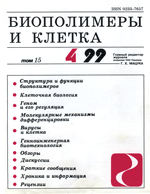Decreasing of glucose level in vitro and in vivo by recombinant vector containing human preproinsulin gene
DOI:
https://doi.org/10.7124/bc.000529Abstract
The expression of human preproinsulin gene was studied. The fragment of genomic DNA, containing the sequences of preproinsulin gene without its personal promoter was cloned in the vector plasmid DNA pTR-UF under control of cytomegalovirus promoter. The obtained recombinant plasmid DNA was tested in vitro, in Hep-2 of tissue culture and in vivo at streptozotocin diabetic mice by introducing the preparation into the liver. As a result of our experiment we found out the reduction of glucose level both in the cells of tissue culture and in the blood of the experimental animals. The presented results, in the author's opinion, evidence about the availability of the expression of the human preproinsulin gene.References
Zolotukhin S, Potter M, Hauswirth WW, Guy J, Muzyczka N. A "humanized" green fluorescent protein cDNA adapted for high-level expression in mammalian cells. J Virol. 1996;70(7):4646-54.
Sambrook J., Fritsch E.F., Maniatis T. Molecular cloning; A laboratory manual . New York: Cold Spring Harbor Lab. press 1989 p. 456
Nishimura A, Morita M, Nishimura Y, Sugino Y. A rapid and highly efficient method for preparation of competent Escherichia coli cells. Nucleic Acids Res. 1990;18(20):6169.
Kriey P., Melton D. Promega Biotech. Catalogue., 1985 pp. DB3DB3.
Graham FL, van der Eb AJ. Transformation of rat cells by DNA of human adenovirus 5. Virology. 1973;54(2):536-9.
Tytok T. G., Evseenko A. A., Adjamiyan F., Kordyum V. A. Different models of the diabetes mellitus in experimental research on animals. Biopolym. Cell. 1999; 15(2):103-108
Margolis LB, Bergelson LD Liposomes and their interaction with cells. Moscow: Nauka, 1986. 240 p.

